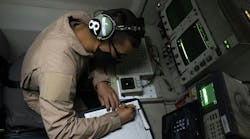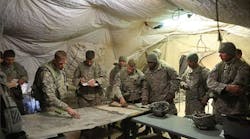by John Keller, chief editor
Military & Aerospace Electronics
I think we need to keep our wits about us as we look over the 2003 budget request of the U.S. Department of Defense (DOD). Some of those big numbers, after all, are downright intoxicating — that is, until we sharpen our pencils and take a closer look.
The top line, for example, is pretty interesting. DOD is asking Congress for $379.3 billion next year. We haven't seen defense budgets this hefty in a decade. That number also represents a 13-percent increase over this year's $334.3 billion DOD budget. That would be, however, if Congress agrees to the request, and we won't know that until next fall.
But let's assume, just for fun, that Congress in its collective wisdom will go along with the Bush Administration request. First off, that would mean an extra $45 billion for defense over what the DOD will spend this year. Before we celebrate, however, let's see what that would mean for defense electronics companies and their suppliers.
DOD officials make no secret of their intention to funnel a big chunk of that increase into the so-called "quality of life" accounts, such as pay raises for soldiers, marines, sailors, and airmen, as well as enhancements to medical care and family housing. No one is going to dispute the fact that our nation's fighting men and women more than deserve these increases.
To subtract the costs of quality-of-life enhancements and get a better idea of where electronics spending could come from, we look at primarily at three accounts in the defense budget — procurement; research, development, test, and evaluation (RDT&E); and operations and maintenance (O&M). The DOD's 2003 procurement budget is up $6.3 billion over this year, the RDT&E budget is up $5.4 billion over this year, and the O&M budget is up $9.9 billion over this year. Now that original $45 billion DOD budget increase shrinks to an increase of only $21.6 billion from which additional electronics money can come.
But how much of that $21.6 billion increase will actually go for electronics? As a rule of thumb, we can assume that 38 percent of the procurement budget pays for electronics, 54 percent of the RDT&E budget goes for electronics, and 8 percent of the O&M budget goes for electronics. That means the DOD is asking for an increase next year of $2.4 billion for electronics in the procurement budget, an increase of $2.9 billion for electronics in the RDT&E budget, and an increase of $796 million for electronics in the O&M budget.
Of that original $45 billion increase in the overall defense budget, we are left with an increase of only $6.1 billion for electronics. In the context of the whole defense budget, it doesn't sound like all that much, but let's remember: it's still six billion dollars. By any measure, that's a nice increase.
Overall, then, DOD officials in 2003 are asking for total electronics spending of $67.2 billion — $29.1 billion for RDT&E electronics, $26.1 billion for procurement electronics, and $12 billion for O&M electronics. That's a healthy market by anyone's evaluation. It simply may not reflect some of our original delirious estimates.
So where is defense electronics spending headed in 2003? Let's sum it up: DOD is requesting $67.2 billion for electronics next year. That represents an increase over this year's defense electronics spending of $61.1 billion, or 9 percent.
Several line items from the 2003 defense procurement budget stand out. The Army, for example, wants $1.6 billion for missile procurement. Some estimates place the electronics content of missiles at 80 percent. If true, the Army wants $1.3 billion next year for missile electronics alone. That Army missile request also is up 53 percent over this year's level.
Inside of that Army missile procurement line item is a request for $471 million for 72 new Patriot anti-missile systems. On top of that is a request for $151.3 million for modifications to the Patriot.
The Army also wants $2.3 billion next year for communications and electronics equipment. That request is up $220 million, or 10.7 percent, over this year's level.
Navy officials evidently have big plans to upgrade at last two classes of carrier-based aircraft. The Navy's 2003 budget has a request of $421.7 million to modify the F/A-18 Hornet fighter-bomber, and another $223.5 million to modify the EA-6B Prowler electronic warfare jet.
The Navy also is asking for $1.7 billion for communications and electronics equipment. That request is up by $242 million over this year's level, or an increase of 16 percent.
Other big-ticket Navy requests for 2003 include $251.9 million for acoustics systems for attack submarines — up $133.6 million, or 113 percent over last year; $132.9 million for submarine communications equipment — up 44.4 million, or 50 percent; and $62.1 million for the ocean-floor Fixed Surveillance System — up $28.7 million, or 86 percent.
Air Force officials have big plans to upgrade several of their front-line combat aircraft. The Air Force's 2003 budget has a request of $265 million to modify the F-16 jet fighter; $232.5 million to modify the F-15 jet fighter; $138.5 million to modify the C-130 utility turboprop; and $128.2 million to modify the C-17 airlifter.
Make no mistake about this 2003 request; this is a wartime budget, and could represent a trend that bodes ill for electronics spending in the long run. Wartime budgets pay for bombs, bullets, food, and gasoline. The necessities of paying for combat operations often edge out electronics procurement and research. We saw that clearly during Vietnam. The Persian Gulf War didn't last long enough to cut deeply into electronics spending.
Consider these numbers: the Navy wants $185.2 million next year to buy 9,880 Joint Direct Attack Munitions, better known as JDAM. That Navy JDAM request is up by $185.2 million, or 454 percent, over last year. The Navy also wants to spend $243.4 million on general-purpose bombs. That's up $178.8 million, or 277 percent over last year. Spending for Navy machine-gun ammunition would be $26.4 million in 2003, up $13.1 million, or 98 percent from this year.
The Air Force wants to spend $378.9 million to buy 17,917 JDAMs next year. That's up by $192.9 million, or 104 percent over this year.
So, on the face of it, the 2003 defense budget request is good news for electronics manufacturers and their suppliers. Several wildcards have yet to be played, however. Congress can change the request in virtually any way in which members want. And how long the global war on terrorism goes on also will have a substantial influence. Keep an eye out.


